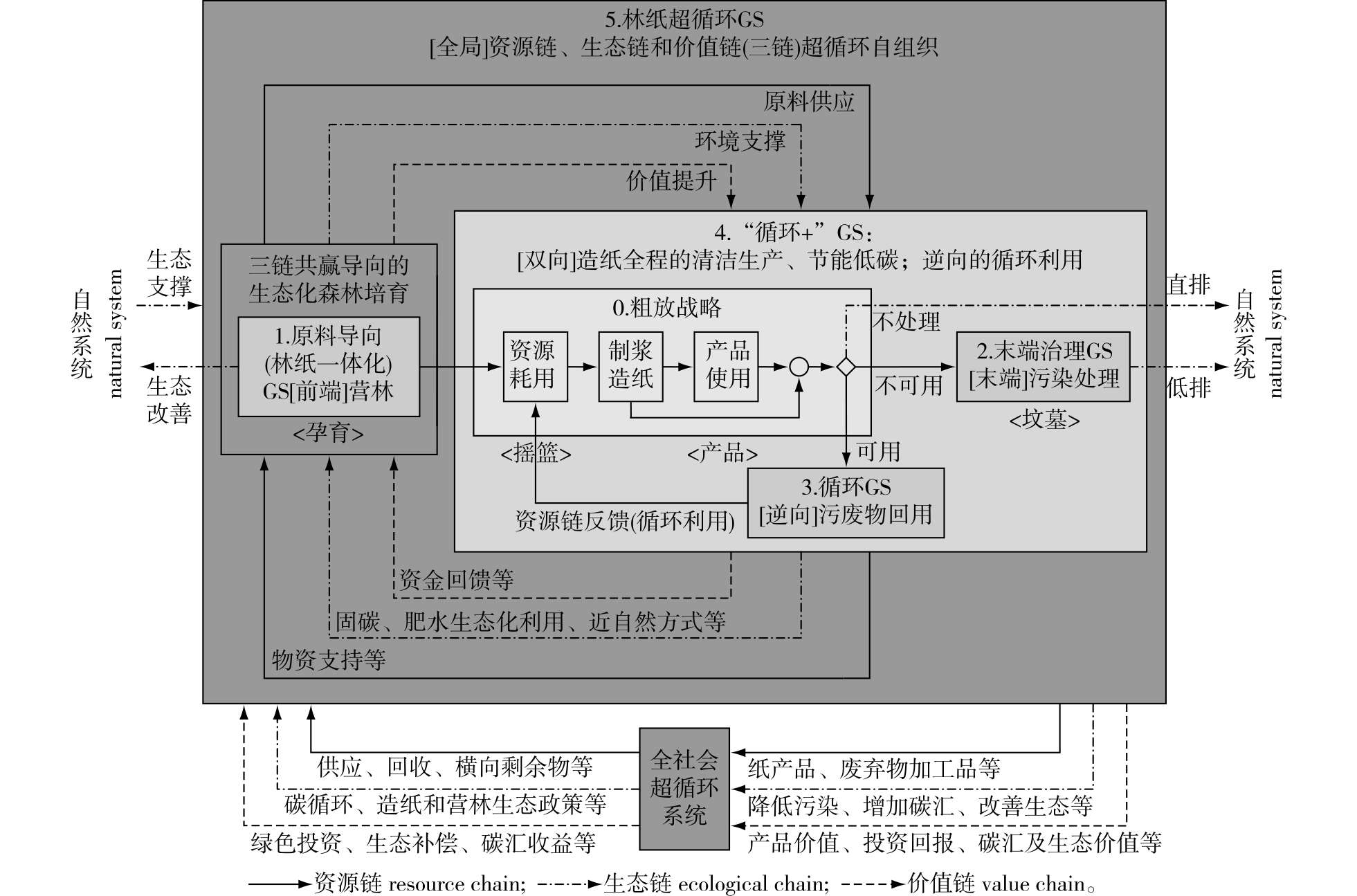 PDF(1873 KB)
PDF(1873 KB)


 PDF(1873 KB)
PDF(1873 KB)
 PDF(1873 KB)
PDF(1873 KB)
中国林业造纸的绿色战略路径:六十年进程与超循环趋势
Green strategic path of Chinese forestry-paper industry: evolution course in the past 60 years and hypercycle trend in the future
【目的】基于林业造纸与生态环境的特殊关联性,梳理和分析我国林业造纸业的绿色战略发展历程与现状,预测未来的战略趋势,进而发掘该战略演进过程的完整路径,并揭示其中的内在规律,为相关企业和管理部门制定并实施绿色战略提供科学依据。【方法】采用文献检索和实地调研法,收集并分析我国林业造纸样本企业绿色战略行为的相关资料和数据,再运用绿色战略理论和系统分析方法,梳理和总结中国林业造纸绿色战略的发展路径,以及战略系统的结构和原理,由此提炼出其整体演进规律和特征。【结果】中国林业造纸绿色战略从萌芽期至今已经走过了60年的发展历程。在萌芽期之后经历了原料导向(林纸一体化)绿色战略(1980年起)、末端治理绿色战略(1990年起)、循环绿色战略(1995年起)和“循环+”绿色战略(1999年起)4个战略发展阶段,各阶段中的战略类型又包含一些具体的下层战略类型。各类战略的起点有差异,但后期相互交织、持续发展。各类战略的实施在经济效益和生态效益两方面都取得了良好的成效,但是也存在一些发展瓶颈。为突破瓶颈,未来的发展趋势是林业造纸超循环绿色战略。【结论】纵观整体的演进历程和未来趋势,中国林业造纸绿色战略在结构和内涵上形成了逐步拓展和逐步深化的演进规律:前端的原料导向战略、末端的污染治理战略、逆向的循环战略(侧重资源回收利用)、双向的“循环+”战略(强化造纸全程和逆向回路),未来将进一步提升到全局的林业造纸超循环战略(资源链、生态链和价值链相互促进的自组织系统)。综合以上成果,最终提炼出中国林业造纸绿色战略的多维演进模型及其演进特征。
【Objective】Based on the special correlation between forestry-paper industry and ecological environment, the development history and current situation of green strategy (GS) in Chinese forestry-paper industry (CFPI) are sorted out and analyzed, and its strategic trend in the future is forecasted, so that the whole strategic evolution path and its inherent law are uncovered to provide scientific basis for relevant enterprises and management departments making and implementing strategic decision of their green strategies.【Method】Document retrieval method and field research method were used to mine and analyze information and data about green strategic behaviors of forestry-paper sample enterprises. Then green strategy theory and system analysis method were applied to explore the development path, system structure and principle of CFPI green strategy. Thereout, the whole evolution law and characteristics are concluded.【Result】The development of CFPI green strategy has gone through 60 years from the sprouting period to the present. It has experienced the following stages of strategic development after the sprouting period: raw material oriented (forest-paper integration) GS (1980-), terminal treatment GS (1990-), circular GS (1995-), “circular +” GS (1999-). Each strategy type in the most stages also contains some specific types of strategies in lower level. These strategy types have different starting points, but in the later period, they are intertwined and keep on developing. The implementation of various strategies has achieved good results in both economic and ecological benefits, but there are also some bottlenecks. In order to break through the bottlenecks, the future development trend is forestry-paper hypercycle green strategy.【Conclusion】Looking at the overall evolution course and future trend, CFPI green strategy has formed an evolutionary law of gradual expansion and deepening both in structure and connotation. The first GS stage focuses on the front end: raw material oriented strategy. The second GS stage focuses on the terminal: pollution treatment strategy. The third GS stage focuses on the reverse (resources recycling): circular strategy. The fourth GS stage focuses on the bidirection (whole papermaking process and reverse loop):“circular +” strategy. The future GS stage will focus on the global of a self-organizing system in which resources-chain, eco-chain and value-chain promote each other: forestry-paper hypercycle strategy. Finally, a multidimensional evolution model and its evolution characteristics of CFPI green strategy are extracted from the above results.

林业造纸 / 绿色战略 / 林纸一体化 / 污染治理 / 循环经济 / “双碳”目标 / 超循环经济
forestry-paper industry / green strategy / forest-paper integration / pollution treatment / circular economy / dual carbon goals / hypercycle economy
| [1] |
汪朝阳. 高分子材料合成与应用中的绿色战略[J]. 化工时刊, 2002, 16(4):7-10.
|
| [2] |
赵培宝, 任爱芝. 发展生态农业、规范基地建设:论我国实施“绿色”战略的现状与策略[J]. 聊城师院学报(自然科学版), 2002, 15(1):68-71.
|
| [3] |
苏甦. 武汉市旅游业发展的绿色战略研究[J]. 林业调查规划, 2003, 28(1):81-83,88.
|
| [4] |
李晓波. 实施绿色战略建设绿色太钢:太钢实施绿色发展战略的认识和实践[J]. 中国钢铁业, 2008(7):6-8.
|
| [5] |
李晓西, 郑艳婷, 蔡宁. 能源绿色战略的国际比较与借鉴[J]. 国家行政学院学报, 2012(6):23-29.
|
| [6] |
严良, 李姣宇, 谢雄标. 资源型企业绿色战略形成过程研究:基于湖北兴发集团的案例[J]. 科技进步与对策, 2014, 31(10):95-100.
|
| [7] |
张智光. 可再生资源型企业的绿色特征与绿色战略类型体系研究:以林业企业为例[J]. 南京林业大学学报(自然科学版), 2020, 44(6):1-8.
|
| [8] |
张智光. 可再生资源型企业绿色战略的演进规律研究:以林业企业为例[J]. 南京林业大学学报(自然科学版), 2021, 45(6):1-11.
|
| [9] |
|
| [10] |
陈小洋. 企业绿色战略[J]. 生态经济, 2002, 18(5):34-37.
|
| [11] |
|
| [12] |
张智光, 杨加猛, 谢煜, 等. 中国林纸一体化进程:实施、研究与政策[J]. 中国造纸学报, 2010, 25(3):64-72.
|
| [13] |
吴福骞. 制浆造纸废水处理技术的发展动向[J]. 上海造纸, 1981, 11(3):1-12,23.
|
| [14] |
《造纸技术通讯》编辑部. 国外造纸工业防治污染的发展趋势[J]. 造纸技术通讯, 1974(1):45-52.
Editorial Department of Paper Technology Newsletter. Development trend of pollution prevention and control in foreign paper industry[J]. Communication of Paper Technology, 1974(1):45-52.
|
| [15] |
《上海造纸》编辑部. 离心沉降在造纸行业中的应用[J]. 上海造纸, 1970(5):15.
Editerial Department of Shanghai Paper Industry. Application of centrifugal sedimentation in papermaking industry[J]. Shanghai Paper Making, 1970(5):15.
|
| [16] |
杨珂, 孙娜娜. 华泰集团45年成功之路启示录[N]. 齐鲁晚报,2021-11-09(2).
|
| [17] |
傅章清. 山东潍坊造纸总厂治理“三废”取得好效益[J]. 纸和造纸, 1987, 6(1):36.
|
| [18] |
《造纸技术通讯》编辑部. 国外废纸回用情况[J]. 造纸技术通讯, 1972(1):61-64.
|
| [19] |
张珂. 西欧制浆与造纸工业中的清洁工艺[J]. 世界环境, 1986(4):29-31,25.
|
| [20] |
沈学勋. 谈上海造纸工业的节能工作[J]. 上海造纸, 1981, 11(1):1-7.
|
| [21] |
张智光, 卑燕. 中国造纸业绿色战略的演进历程[J]. 中国造纸学报, 2024, 39(1):1-12.
|
| [22] |
张智光. 绿色中国.第2卷,绿色共生型供应链模式[M]. 北京: 中国环境科学出版社, 2011.
|
| [23] |
张智光. 论林业经济的系统观[J]. 林业经济问题, 2023, 43(3):225-239.
|
| [24] |
张智光. 共生与个体理性模式下绿色供应链期望收益的理论分析[J]. 现代经济探讨, 2014(4):18-22.
|
| [25] |
张智光. 人类文明与生态安全:共生空间的演化理论[J]. 中国人口·资源与环境, 2013, 23(7):1-8.
|
| [26] |
张智光. 面向生态文明的超循环经济:理论、模型与实例[J]. 生态学报, 2017, 37(13):4549-4561.
|
/
| 〈 |
|
〉 |